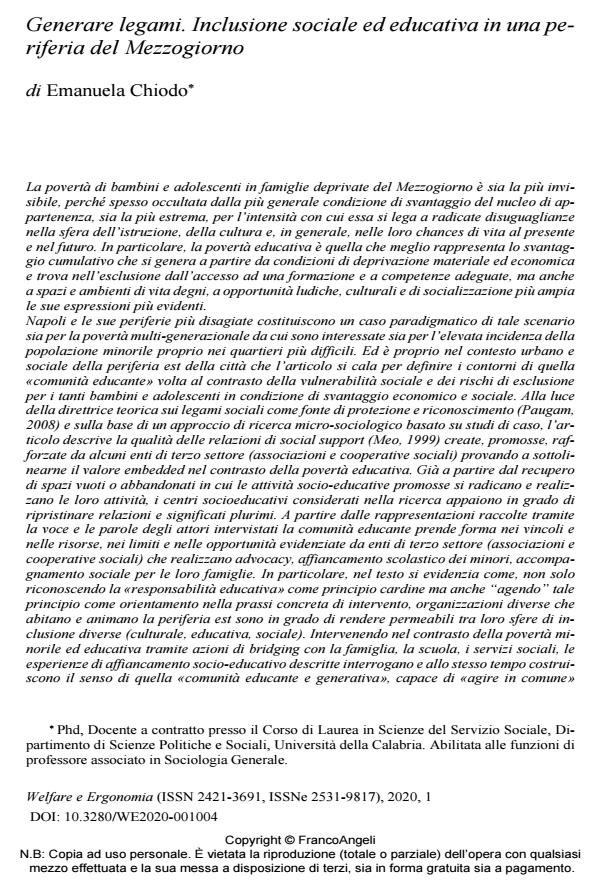Social liaisons. Social inclusion and contrast of educational poverty in a suburb of South Italy
Journal title WELFARE E ERGONOMIA
Author/s Emanuela Chiodo
Publishing Year 2020 Issue 2020/1
Language Italian Pages 10 P. 29-38 File size 285 KB
DOI 10.3280/WE2020-001004
DOI is like a bar code for intellectual property: to have more infomation
click here
Below, you can see the article first page
If you want to buy this article in PDF format, you can do it, following the instructions to buy download credits

FrancoAngeli is member of Publishers International Linking Association, Inc (PILA), a not-for-profit association which run the CrossRef service enabling links to and from online scholarly content.
Poverty of children and adolescents in deprived families of the South Italy is both the most invisible, because it is often concealed by the more general disadvantage of the nucleus of be-longing, and the most extreme, due to the intensity with which it binds to deep-rooted inequali-ties in the sphere education, culture and, in general, in their chances of life in the present and in the future. In particular, educational poverty is the one that best represents the cumulative disadvantage starting from conditions of material and economic deprivation and aggravated by exclusion in recreational, cultural and socialization opportunities. Naples and its most disadvantaged suburbs constitute a paradigmatic case of this scenario both for the multi-generational poverty from which they are affected and for the high inci-dence of the juvenile population in the most difficult neighborhoods. And it is precisely in the urban and social context of the eastern suburbs of the city that the article define the contours of the "educating community" aimed at contrasting social vulnerability and exclusion risks for children and adolescents. In the light of the theoretical guideline on social bonds as a source of protection and recognition (Paugam, 2008) and based on a micro-sociological research approach, the article describes the quality of social support relationships (Meo, 1999) created and promoted by some third sector organizations (associations and social coopera-tives) in the fight against educational poverty. In particular, the article highlights how, not only by recognizing "educational responsibility" as a cardinal principle but also by "acting" this principle as an orientation in the concrete intervention practice, different organizations in the eastern suburbs are able to combine different spheres of inclusion (cultural, educational, social). Through bridging actions with the family, school, social services, the experiences of socio-educational support described, question and build the meaning of the «educating and generative community» like «acting in common» by adopting «an inclusive, integrative and enabling way of doing things» (Magatti and Giaccardi, 2014).
Keywords: Educational poverty; social inclusion; South Italy; suburbs; Childhood; social work.
Emanuela Chiodo, Generare legami. Inclusione sociale ed educativa in una periferia del Mezzogiorno in "WELFARE E ERGONOMIA" 1/2020, pp 29-38, DOI: 10.3280/WE2020-001004